Congenital Heart Disease
According to the American Heart Association, about 9 of every 1,000 babies born in the U.S. have a congenital heart defect. This is a problem that occurs as the baby's heart is developing during pregnancy, before the baby is born. Congenital heart defects are the most common birth defects.
A baby's heart starts to develop at conception, but is completely formed by 8 weeks into the pregnancy. Congenital heart defects happen during this important first 8 weeks of the baby's development. Specific steps must take place for the heart to form correctly. Often, congenital heart defects are a result of one of these steps not happening at the right time. For example, a hole is left where a dividing wall should have formed, or a single blood vessel is left, where 2 should have been.
What causes congenital heart disease?
Most congenital heart defects have no known cause. Mothers will often wonder if something they did during the pregnancy caused the heart problem. In most cases, no specific cause can be found. Some heart problems do occur more often in families, so there may be a genetic link to some heart defects. Some heart problems are likely to occur if the mother had a disease while pregnant and was taking medicines, such as antiseizure medicines or the acne medicine isotretinoin. But, most of the time, there is no clear reason for the heart defect
Congenital heart problems range from simple to complex. Some heart problems can be watched by the baby's doctor and managed with medicines. Others will require surgery, sometimes as soon as in the first few hours after birth. A baby may even "grow out" of some of the simpler heart problems, such as patent ductus arteriosus or atrial septal defect. These defects may simply close up on their own with growth. Other babies will have a combination of defects and require several operations throughout their lives.
What are the different types of congenital heart defects?
Experts classify congenital heart defects into several categories to better understand the problems the baby will experience. They include:
-
Problems that cause too much blood to pass through the lungs. These defects allow oxygen-rich blood that should be traveling to the body to recirculate through the lungs, causing increased pressure and stress in the lungs.
-
Problems that cause too little blood to pass through the lungs. These defects allow blood that has not been to the lungs to pick up oxygen (and, therefore, is oxygen-poor) to travel to the body. The body does not get enough oxygen with these heart problems, and the baby may be cyanotic, or have a blue coloring.
-
Problems that cause too little blood to travel to the body. These defects are a result of underdeveloped chambers of the heart or blockages in blood vessels that prevent the proper amount of blood from traveling to the body to meet its needs.
Again, in some cases there will be a mix of several heart defects. This creates a more complex problem that can fall into several of these categories.
Some of the problems that cause too much blood to pass through the lungs include the following:
-
Patent ductus arteriosus (PDA). This defect occurs when the normal closure of the ductus arteriosus, which is present in all fetuses, does not occur. Extra blood goes from the aorta into the lungs and may lead to "flooding" of the lungs, rapid breathing, and poor weight gain. PDA is often seen in premature infants.
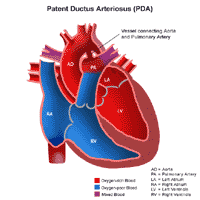
Click Image to Enlarge
-
Atrial septal defect (ASD). In this condition, there is a hole between the 2 upper chambers of the heart—the right and left atria. This causes an abnormal blood flow through the heart. Some children may have no symptoms and appear healthy. However, if the ASD is large, permitting a large amount of blood to pass to the right side, symptoms will be noted.
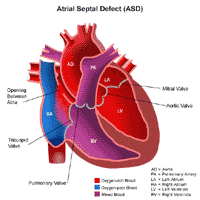
Click Image to Enlarge
-
Ventricular septal defect (VSD). In this condition, a hole in the ventricular septum (a dividing wall between the 2 lower chambers of the heart— the right and left ventricles) occurs. Because of this opening, blood from the left ventricle flows back into the right ventricle, due to higher pressure in the left ventricle. This causes an extra volume of blood to be pumped into the lungs by the right ventricle, which can create congestion in the lungs.
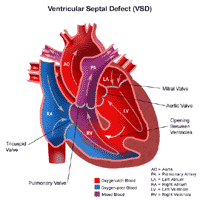
Click Image to Enlarge
-
Atrioventricular canal (AVC or AV canal). AVC is a heart problem that involves several abnormalities of structures inside the heart. These include atrial septal defect, ventricular septal defect, and improperly formed mitral and/or tricuspid valves.
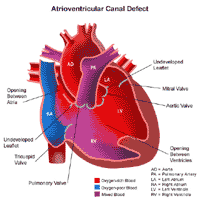
Click Image to Enlarge
Some of the problems that cause too little blood to pass through the lungs include the following:
-
Tricuspid atresia. In this condition, the tricuspid valve does not form. Therefore, no blood flows from the right atrium to the right ventricle. Tricuspid atresia is characterized by the following:
A series of surgical procedures are often needed to increase the blood flow to the lungs and establish separate circulations.
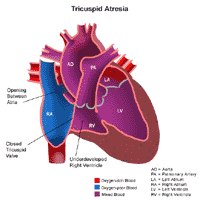
Click Image to Enlarge
-
Pulmonary atresia. A congenital defect in which the pulmonary valve or artery are underdeveloped. Normally, the pulmonary valve is found between the right ventricle and the pulmonary artery. It has 3 leaflets that function like a one-way door, allowing blood to flow forward into the pulmonary artery, but not backward into the right ventricle.
With pulmonary atresia, problems with valve development prevent the leaflets from opening, therefore, blood cannot flow forward from the right ventricle to the lungs.
-
Transposition of the great arteries. With this congenital heart defect, the positions of the pulmonary artery and the aorta are reversed, thus:
-
The aorta originates from the right ventricle, so most of the oxygen-poor blood returning to the heart from the body is pumped back out without first going to the lungs.
-
The pulmonary artery originates from the left ventricle, so that most of the oxygen-rich blood returning from the lungs goes back to the lungs again
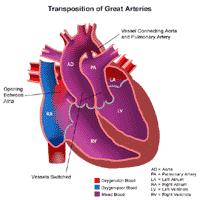
Click Image to Enlarge
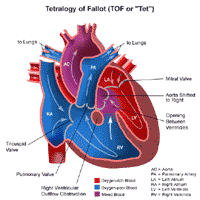
Click Image to Enlarge
-
Double outlet right ventricle (DORV). A complex form of congenital heart defect, in which both the aorta and the pulmonary artery are connected to the right ventricle.
-
Truncus arteriosus. During normal fetal development, the aorta and pulmonary artery start as a single blood vessel, and then the vessel divides into 2 separate arteries. Truncus arteriosus occurs when the single great vessel fails to separate completely. This leaves a large connection between the aorta and the pulmonary artery.
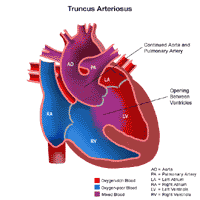
Click Image to Enlarge
Some of the problems that cause too little blood to travel to the body include the following:
-
Coarctation of the aorta (CoA). In this condition, the aorta is narrowed or constricted. This obstructs blood flow to the lower part of the body and increases blood pressure above the constriction. Usually there are no symptoms at birth, but they can develop as early as the first week of life. If severe symptoms of high blood pressure and congestive heart failure develop, surgery may be considered.

Click Image to Enlarge
-
Aortic stenosis (AS). In AS, the aortic valve between the left ventricle and the aorta did not form properly and is narrowed. This makes it difficult for the heart to pump blood to the body. A normal valve has 3 leaflets or cusps, but a stenotic valve may have only 1 cusp (unicuspid) or 2 cusps (bicuspid).
Although aortic stenosis may not cause symptoms, it may worsen over time. Surgery or a catheterization procedure may be needed to correct the blockage, or the valve may need to be replaced with an artificial one.
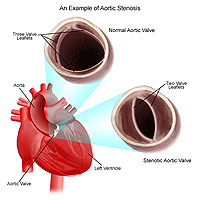
Click Image to Enlarge
A complex combination of heart defects known as hypoplastic left heart syndrome can also occur.
-
Hypoplastic left heart syndrome (HLHS). A combination of several abnormalities of the heart and the great blood vessels. In HLHS, most of the structures on the left side of the heart (including the left ventricle, mitral valve, aorta, and aortic valve) are small and underdeveloped. The degree of underdevelopment differs from child to child. The left ventricle may not be able to pump enough blood to the body. HLHS is fatal without treatment.
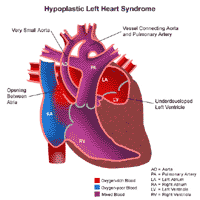
Click Image to Enlarge
Who treats congenital heart defects?
Babies with congenital heart problems are followed by specialists called pediatric cardiologists. These doctors diagnose heart defects and help manage the health of children before and after surgical repair of the heart problem. Specialists who correct heart problems in the operating room are known as pediatric cardiovascular, or cardiothoracic surgeons.
A new subspecialty within cardiology is emerging, as the number of adults with congenital heart disease (CHD) is now greater than the number of babies born with CHD. This improved survival is a result of advances in diagnostic procedures and treatment interventions.
To achieve and maintain the highest possible level of wellness, it is imperative that anyone born with CHD, who has reached adulthood, transition to the appropriate type of cardiac care. The type of care required is based on the type of CHD a person has. Those with simple CHD can generally be cared for by a community adult cardiologist. Those with more complex types of CHD will need to be cared for at a center that specializes in adult CHD.
For adults with CHD, guidance is necessary for planning key life issues, such as college, career, employment, insurance, activity, lifestyle, inheritance, family planning, pregnancy, chronic care, disability, and end of life. Knowledge about specific congenital heart conditions, and expectations for long-term outcomes and potential complications and risks, must be reviewed as part of the successful transition from pediatric care to adult care. Parents should help pass on the responsibility for this knowledge, and accountability for ongoing care to their young adult children. This will help ensure the transition to adult specialty care and will optimize the health status of the young adult with CHD.